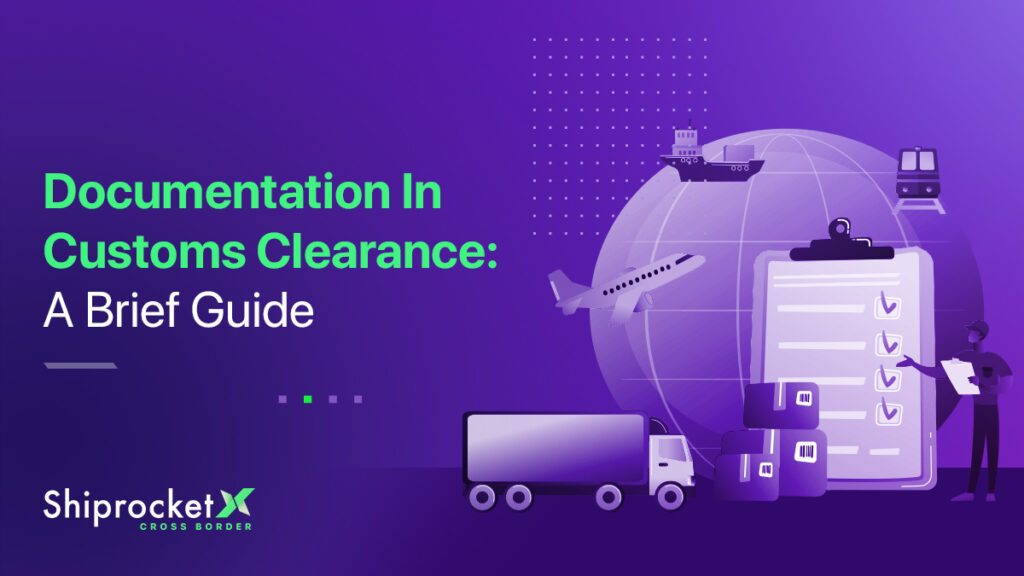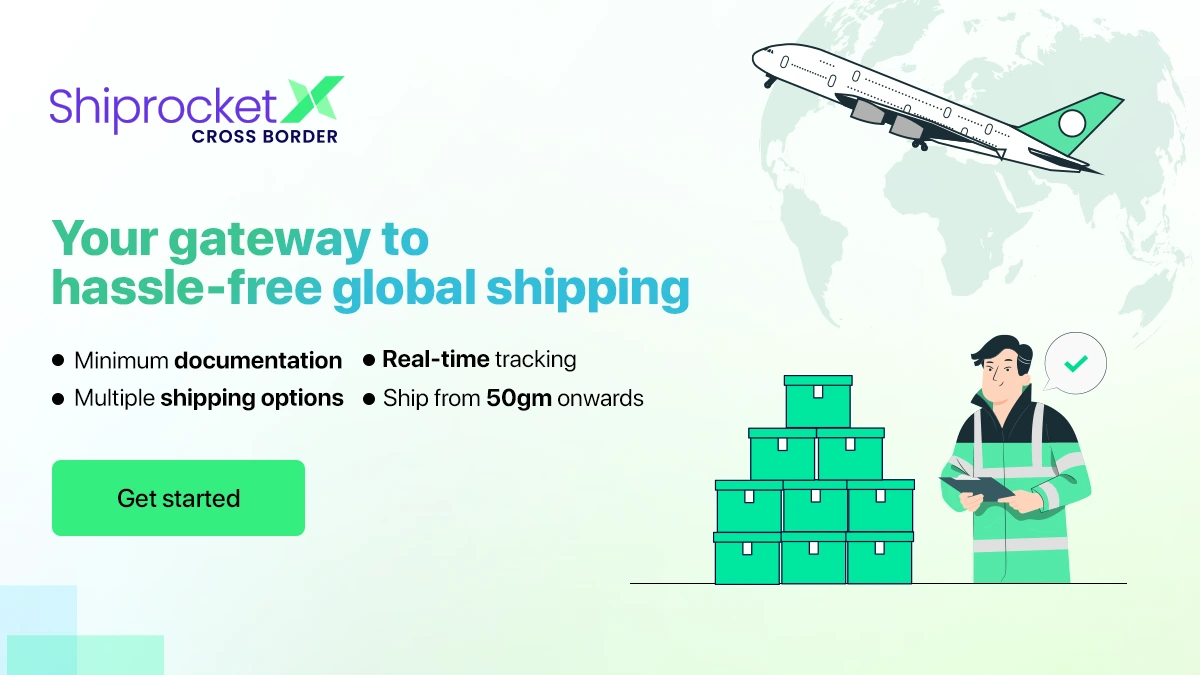Essential Documents For A Smooth Customs Clearance
Did you know that all consignments intended for international destinations must go through a customs clearance process? Each country is governed by its laws, and all carriers, shipping companies, and freight carriers need to be aware of them. Skipping any of the mandatory customs clearance documents is not permissible under the law.
Before submitting your consignment, ensure you have the necessary documents verified during the customs clearance process in India. You can handle the customs clearance electronically or physically, along with your shipment. Having your documents in order is crucial. It helps officials calculate taxes and duties accurately, ensuring a smooth verification process for your consignment.
When it comes to clearing customs for your international orders, customs rules and levies vary from country to country. However, there are a few documents that are mandatory globally. A company like ShiprocketX helps you breeze through the formalities easily.

List of Required Documents for the Customs Clearance Process
Whenever goods are brought into or sent out of the country, they have to go through customs clearance first. Let’s go over some of the essential customs clearance documents required for the process.
Export Document Required for Custom Clearance
ProForma Invoice
A ProForma invoice is similar to a purchase order and furnishes details of the product being sold. Each ProForma invoice is generated based on the mutually agreed terms and conditions between the exporters and the importers.
The terms may be communicated via email, fax, telephone, virtual meeting, or personal meeting. A ProForma invoice is essential in the export customs clearance process, and you must generate it before the sales transaction is completed.
Customs Packing List
A customs packing list is a detailed list of items to be sent in the export shipment. The buyers or importers can cross-verify the list with the ProForma invoice to check if the description matches.
The customs packing list is mandatory for the customs clearance process with documents. It is sent along with an international shipment and contains information about the shipped items.
Country Of Origin Certificate (COO)
A country of origin certificate is a document issued by the exporting company, stating that the goods were made or processed in the mentioned country. This helps determine where the goods come from. So, the exporting company declares that the products were created in that specific country.
Commercial Invoice
A commercial invoice is an essential custom clearance document for exporting. It’s the first thing the customs wants to see, as it lays out all the key details about the order.
These details include descriptions of the goods, selling prices, quantities, packaging costs, weights, and measurements. This information allows customs at the destination port to determine the proper import value and other factors like insurance, delivery terms, and payment arrangements.
Customs officials go through the commercial invoice with great detail to ensure it matches the actual order specifications. Based on this document, they decide whether to clear the shipment for delivery or not.
Shipping Bill
As the name implies, a shipping bill is a document that serves as a permanent record for the export transaction. One can submit it electronically using an online software system (ICEGATE).
Exporters need to assemble paperwork to get that shipping bill ready for exports. You’ll require:
- GR Forms for all destinations
- A detailed Packing List for providing details about each container
- Any required Export Licences
- Purchase Order: a document the buyer hands over to confirm the order details.
- Thorough Invoices listing package details, quantities, prices, and precise goods specifications
- Letters of Credit, AR4 forms, Quality Control Certificates, and even Port Trust documents.
- Export Declaration Form: A form detailing the exported goods and their destination.
Note: The specific documents required may vary based on the nature of the goods, destination country, and trade regulations. It’s advisable to consult with relevant authorities or a customs broker for accurate and up-to-date information.
Bill Of Lading or Airway Bill
A bill of lading is a document issued by the carrier to the exporter. It is documentary evidence of a mutual contract for shipping goods. The bill will contain details of the product, the type, quantity, and destination of the goods.
The exporter, carrier, and receiving party need to sign this document. The bill of lading is to be produced at the destination as a shipment receipt and is handed over to the country’s customs office for clearance.
Bill Of Sight
The bill of sight is a declaration given to the customs department if the importer or receiver is unaware of the nature of the shipped goods. The receiver can inspect the goods before paying the relevant duties using the bill of sight.
The bill of sight has to include a letter from the exporter to enable clearance of the goods by the customs officials.
Letter Of Credit
The letter of credit is a document furnished by the importer’s bank undertaking to honour the payment to the exporter. A letter of credit ensures that the importer will pay the invoice amount.
Bill Of Exchange
A bill of exchange is like an IOU or a promissory note and is drawn by banks or individuals. It is a payment substitute, and the importer is bound to clear the payment for the goods on demand or as mutually agreed.
Export Licence
An exporter needs an export licence from the respective authorities, issued by the Chief Controller of Imports and Exports. Any business intending to export goods should have a valid export licence, which they must produce when customs officials ask for it. An export licence is required for internationally shipped goods.
Warehouse Receipt
A warehouse receipt is generated after the exporter has paid all the mandatory export duties and freight charges.
Health Certificate
If a business is exporting food products to international destinations, it must obtain a health certificate. The document certifies that the food products in the consignment meet all health and safety standards and that the food is fit for human consumption. Food products cannot be shipped to international destinations without a health certificate.
Import Documents for Custom Clearance Process
Bill of Entry
The Bill of Entry is an important document that needs to be filled out and signed while importing. Whether you import by yourself, using a customs broker, or a shipping company – this paperwork is mandatory. You submit the Bill of Entry along with other documents so customs can inspect and review everything.
Their inspection checks that the imported items follow all the rules and regulations, and that you properly declare what you bring in. Once that’s done and cleared by customs, importers can apply for tax credits on the goods if they qualify.
Thus, the Bill of Entry kicks off the customs clearance process, allowing the authorities to verify the shipment and enabling importers to claim benefits like tax credits.
Import Licence
For certain restricted items that the government monitors, you need to get an Import License before bringing them into India. This licence gives you the official go-ahead from the authorities to import those kinds of controlled goods.
Businesses have to submit an application to the licensing officials to get one of these import licences and enjoy its benefits. This licence ensures only authorised importers can bring in restricted items, helping regulate what flows into the country.
As an importer, you need this customs clearance document to avoid any legal trouble and carry out smooth imports.
Insurance certificate
The Insurance Certificate is an important customs clearance document you need when importing goods. Its main purpose is to show customs officials whether the listed selling price includes insurance coverage or not.
So, providing details on whether the price includes insurance gives transparency to the shipment’s true value through the insurance certificate.
In turn, the insurance certificate helps customs reps accurately calculate the total value of your shipment. This total value directly affects how much import duties and fees the authorities charge you.
GATT/DGFT Declaration
When importing goods, every importer has to submit what’s called a GATT/DGFT declaration to customs. This document is required for customs clearance in India based on the guidelines laid out by the legal agreement GATT (General Agreement on Tariffs and Trade), which many countries signed together to promote international trade by alleviating or eliminating trade barriers, like tariffs or quotas.
This declaration is an essential customs clearance document that determines your expense in customs duties and taxes on your imported shipment. So, it’s crucial that the importer or their representative fills it out accurately and completely.
You’ll need to keep three copies of the declaration, including two for customs and one for yourself. These forms, along with the detailed customs paperwork, must be kept for three years.
Importers must follow all the requirements to the letter when filling out this GATT/DGFT declaration. Properly doing so is essential for getting your imports through customs hassle-free without any delays.
Technical Write-Up
For certain products, you need to provide a Technical Write-Up. This document gives a detailed rundown of the shipment item’s features and usage. The write-up allows authorities to clearly understand what the product is and what it does. It outlines all the specialisations and functions so the officials can properly define the characteristics and any added value.
By explaining the nitty-gritty details of the product, the Technical Write-Up helps the authorities and anyone involved in the import/export process efficiently handle it. It serves as a handy guide conveying all the essential info about the goods.
Industrial Licence
You might need an Industrial License to import a particular category of goods, which this licence covers. This custom clearance document basically proves to customs that you’re eligible for import duty discounts or other incentives on those items.
In some cases, customs will flat-out require you to show a copy of your industrial licence as part of the clearance process. It demonstrates your authority to conduct industrial activities related to the commodities you’re bringing in.
Importers use the Industrial License to access the various benefits and concessions the government provides to promote industrial development and trade.
Import General Manifest (IGM)
When vessels carrying imported goods arrive in India, the carrier (like an airline or shipping line) is responsible for alerting customs at the port or airport – not the importer.
Before the goods even get here, the person in charge of the vehicle has to electronically file an Import General Manifest detailing all the cargo on board.
After reviewing this manifest and verifying documents, customs will grant entry to the vessel, assign an IGM number, and allow unloading of the cargo.
Once the vessel arrives, the goods remain in the custody of an approved custodian until customs clearance is complete. You must include a note in the manifest to unload the goods.
Custom Clearance Documents for Export & Import
Registration cum Membership Certificate (RCMC)
The RCMC, or Registration cum Membership Certificate, is a customs clearance document you need from any of the Export Promotion Councils (EPCs) of India. If you’re an exporter or importer looking for benefits under the government’s Foreign Trade Policy (FTP) or any Export Promotion Council schemes, you’ll have to show your RCMC at customs.
This certificate proves you’re a member of these councils. Having an RCMC allows exporters and importers to take advantage of many trade benefits and incentives offered by the government. It’s a required step if you want to participate in international trade and get the support provided through the government’s trade promotion policies.
Import Export Code
The Import Export Code is the key document required for customs clearance when you import or export something.
Getting an IE code unlocks many benefits that can really help grow your business. IEC registration is a mandatory document required for customs clearance in India if you want to operate legally in imports and exports.
The good news is applying for an Import Export Code through IndiaFilings is a smooth process. You’ll have that critical code in hand within just 6 to 7 days.
ShiprocketX can make international shipping easier for you by taking over all you global export worries. You can experience hassle- free simplified shipping, where all aspects including customs clearance, documentation, pick up and delivery are made easier for you. Now ship to over 220 countries effortlessly.
Summary: Easy Documentation For Seamless Customs Clearance
In a recent survey, it was found that the Indian Government has a big plan to support local production and make it easier for small businesses to export globally. They’ve worked on simplifying the customs clearance process in India, aiming to help small businesses thrive.
The country has emerged as an export hub, thanks to Atmanirbhar Bharat, which encourages small and large exporters. In April 2024, India’s estimated services export value hit a whopping USD 29.57 billion. That’s a solid increase from the USD 25.78 billion exported in April 2023. As for services imports, the estimated value in April 2024 was USD 16.97 billion, up from USD 13.96 billion the previous April.







